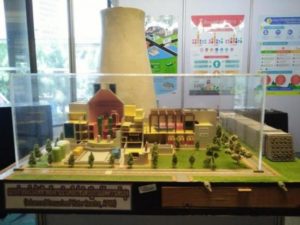
The pitfalls of ‘going nuclear’ for Thailand
Reports that the energy ministry is conducting a feasibility study into developing small nuclear power plants have been met with mixed reactions — from welcome, mainly by the energy and industrial sectors, to reluctance and fear.
The split response was anticipated. Although Thailand has aspired to “go nuclear” for almost four decades, valid fears — solidified by tragic accidents at nuclear power plants in Chernobyl in Ukraine in 1986 and Fukushima in Japan in 2011, as well as domestic accidents involving radioactive waste — remain about whether Thai-style management can cope with technology so reliant on highly efficient, transparent and trustworthy leadership.
This time, the government expects less resistance as it has downsized its aspiration of operating a large-scale traditional nuclear reactor to running a “small modular reactor” (SMR), with a capacity of up to 300 megawatts per unit, about one-third of the generating capacity of larger, traditional nuclear power plants.
SMR technology, known for its portability and less demanding infrastructure development, has a swiftly growing reputation. Russia’s Akademik Lomonosov, which became the world’s first floating nuclear power plant in May 2020, produces energy from two 35 MW(e) SMRs. More than 80 commercial SMR facilities, either under construction or in the licensing stages, are currently being developed in Argentina, Canada, China, Russia, South Korea and the United States of America, among others.
The Electricity Generating Authority of Thailand (Egat) expects to build two 300MW plants with a view to seeing them become fully operational by the end of 2037. If successful, they will be the country’s first nuclear power plants. Egat had been plotting the development of a large-scale pilot nuclear plant between 2009 and 2011. However, that scheme was shelved following the Fukushima incident, when a massive earthquake and tsunami triggered a nuclear reactor meltdown and radiation leak at Japan’s coastal nuclear facility in March 2011.
While the SMR technology sounds promising, the government cannot expect the general public to support the plan so easily. Lest we forget, the use of nuclear technology has been small and limited to medical and industrial tasks. Accidents related to the mishandling of radioactive waste have already eroded trust in the Thai government’s ability to handle nuclear technology.
Over 23 years ago, a cobalt-60 cylinder used for radiology treatment went missing from a warehouse in Bangkok and ended up in the hands of a refuse scavenger, who sold it to a scrap dealer, who in turn broke the highly radioactive tube into various pieces to be resold. The outcome was tragic, as 1,872 people living around the scrapyard were found to have been exposed to harmful levels of radiation. Three people — two scrapyard workers and the scrapyard owner’s husband — died two months later from radiation sickness.
In March last year, a tube containing radioactive Caesium-137 went missing from the National Power Plant 5A Company’s facility in Prachin Buri province before later being found, burned, in a scrap metal factory.
However, while the environmental impact, local community feedback and the as-yet-unproven financial viability of SMR technology must be considered, the main challenge is Thai authorities’ poor record with radioactive waste management and transparency in general.
Without a significant turnaround in public opinion, the government’s nuclear aspirations will likely remain just another pipe dream.
Bangkok Post editorial column
These editorials represent Bangkok Post thoughts about current issues and situations.
Source: https://www.bangkokpost.com/opinion/opinion/2837983/the-pitfalls-of-going-nuclear

